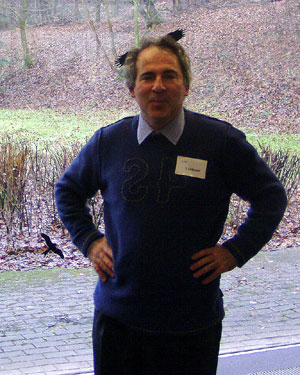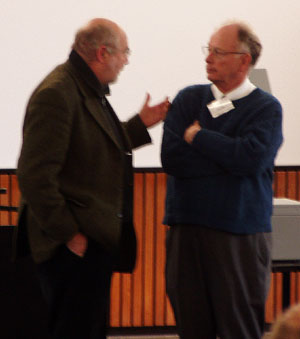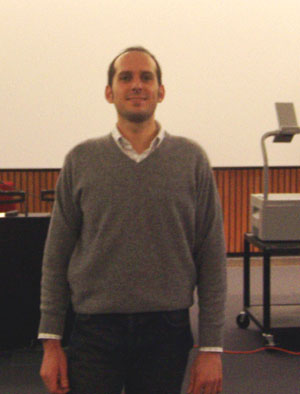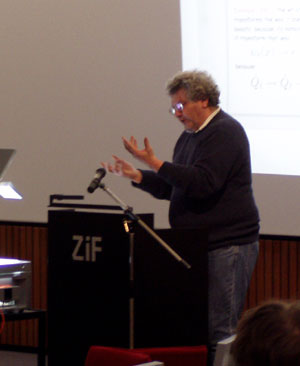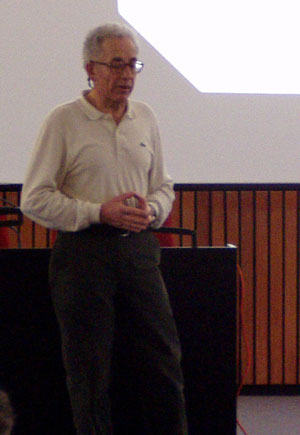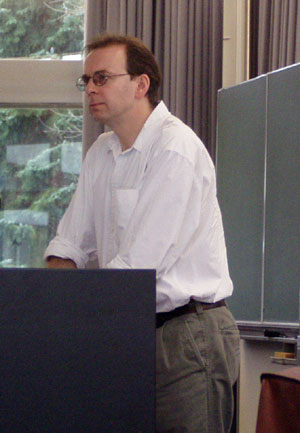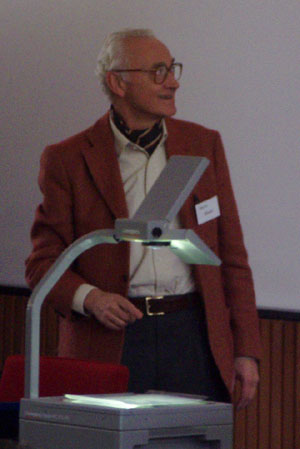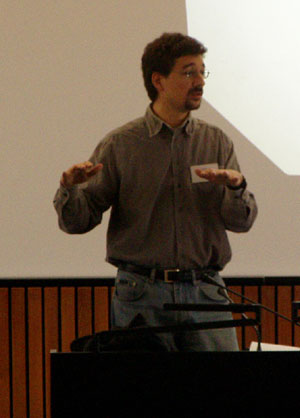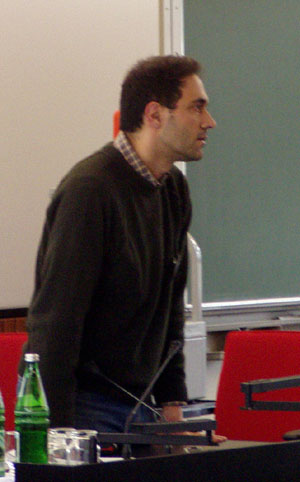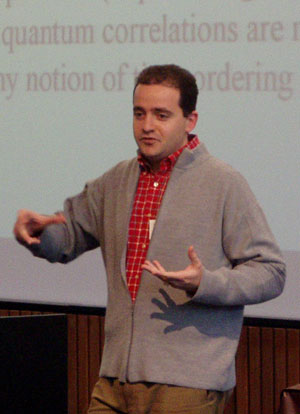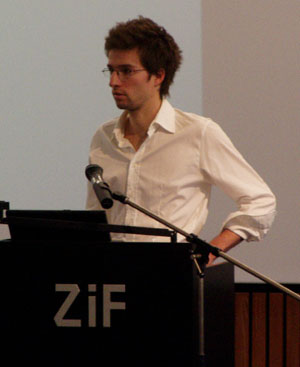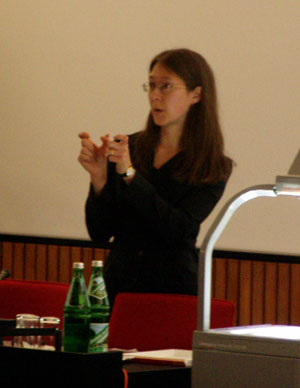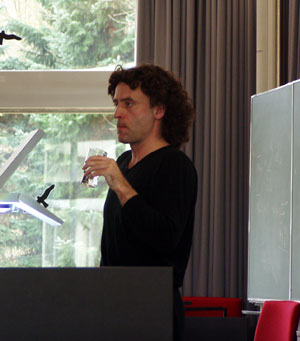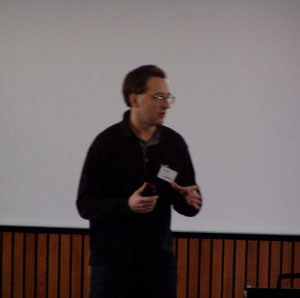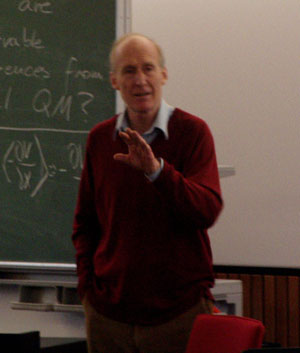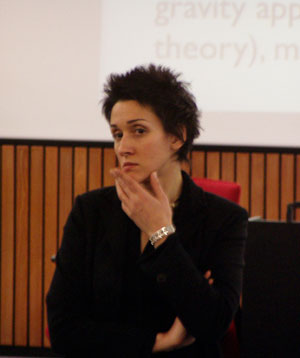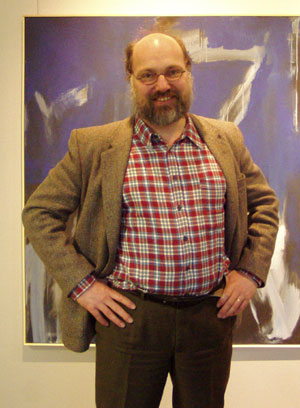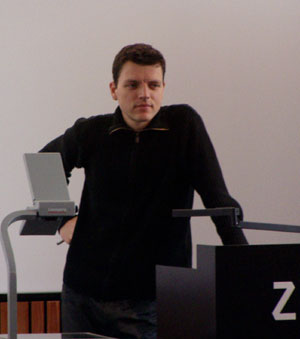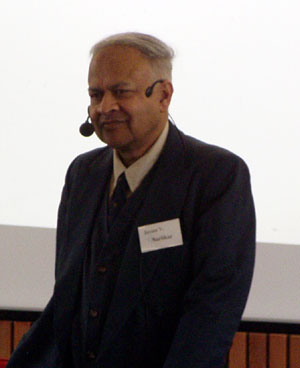Talks & Reviews
for an exact time table please have a
look at the schedule
|
Tuesday |
Wednesday |
Thursday |
Friday |
|
|
|
|
|||
|
|
|
|||
|
|
|
|
|

---------------------- Reviews ---------------------
Abstracts can be send to
tilo.moser@mathematik.uni-muenchen.de
many thanks, Dirk - André Deckert
--------------------------------------------------
Monday
Stephen
Adler: Quantum theory as an emergent phenomenon
|
|
|
Lev
Vaidman: The many worlds interpretation as a quantum theory
without observers
|
|
The Many-Worlds Interpretation (MWI) can be considered as a Quantum Theory without an Observer (QTWO) by defining that within a world there are no macroscopic objects in superposition [http://plato.stanford.edu/entries/qm-manyworlds]. I argue that such MWI is the best QTWO since alternatives require more complicated mathematical structures. Recognizing that in the framework of the MWI there cannot be an objective probability of an outcome of a measurement, since all outcomes are actualized, I argue that the concept of measure of existence replaces successfully the concept of probability, and that it can be understood as an ignorance (subjective) probability of an observer before she recognizes the outcome. I show that the concept of measure of existence of future worlds is useful for analyzing the questions of probability [http://xxx.lanl.gov/pdf/quant-ph/0111072]. Moreover, even the measure of existence of a present world has physical meaning: it yields the ability of the world to interfere with other worlds [http://xxx.lanl.gov/pdf/quant-ph/9609006]. |
James
Hartle: Introduction to decoherent histories
|
|
|
Angelo
Bassi: A model of spontaneous wave-function collapse
|
|
Collapse models aim at describing, whithin one single dynamical equation, both the quantum properties of microscopic systems and the classical properties of macroscopic objects. Here we discuss the properties of a stochastic differential equation describing the evolution of a free particle subject to space-localizations. In particular, we will see that: a) At the microscopic level the stochastic terms affect in a negligible way the quantum properties of the system: accordingly, the model recovers all know predictions of Quantum Mechanics. b) At the macroscopic level, the wavefunction of the center of mass of a macro-object is very well localized in space and it moves obeying the classical laws of motion. From a more mathematical point of view, it can be proved: i) An existence and uniquess theorem for the solutions of the equation. ii) Square-integrable wavefunctions remain square-integrable through time. iii) Any initial wavefunction converges asymptotically towards a Guassian wavefunction corresponding to an almost minimum state of uncertainity (relative to the position and momentum operators). |
Nino
Zanghi: Quantum theory without observers, but with what?
|
|
|
Tuesday
Lodovico
Lanz: Consistency of quantum theory and macroscopic objectivity
|
|
An isolated confined system is described in the context of non-relativistic quantum field theory: classical state parameters are introduced, entering into the statistical operator describing the system. One has to choose a suitable set of "relevant" operator valued fields, with a "quasilocal" structure in terms of quantum fields (e.g. mass, momentum, energy densities) and considers generalised Gibbs states, where these quantum fields appear integrated over the classical time dependent fields: these fields have the role of "beables", bearing a direct objective meaning. Deterministic dynamics in terms of a trajectory of these state parameters arises when a "non equilibrium statistical operator" can be constructed, related to the reference Gibbs state. In such a situation no need of the concept of microsystem appears. However our formalism indicates that the general dynamics of a system is "piecewise" deterministic: demixtures (relatively to the selected relevant variables), must be cosidered in terms of subcollections related to different state parameters. In this way the concept of an event naturally arises and one arrives to the structure of a non equilibrium statistical operator perturbed by a microsystem; in the limit in which its dynamics can be split off, quantum mechanics of the microsystem is recovered. In this way a concrete anchorage of the axiomatic appoach to quantum mechanics developped by Ludwig, inside a quantum field theory of macroscopic systems, seems to be possible. |
Jonathan Halliwell: Decoherence of histories by local conservation and
the emergence of hydrodynamic equations
|
|
We investigate the decoherence of histories of local densities for linear oscillators models. It is shown that histories of local number, momentum and energy density are approximately decoherent, when coarse-grained over sufficiently large volumes. Decoherence arises directly from the proximity of these variables to exactly conserved quantities (which are exactly decoherent), and not from environmentally-induced decoherence. This result indicates that conservation laws define a preferred basis. We also discuss the approach to local equilibrium and the subsequent emergence of hydrodynamic equations for the local densities. |
Alberto Rimini: Quantitative theory of reduction: relativistic
perspectives
|
|
The most reliable nonrelativistic reduction theory is shortly reviewed. The Schroedinger evolution is there modified by a stochastic process which induces a suitable set of macroscopic quantities to have definite values. The difficulties encountered in the search of a relativistic generalization are discussed. It is stressed that a relativistic formulation cannot renounce the macroscopic character of the quantities to be stochastically induced to have definite values. The most natural framework for a relativistic reduction theory is the Tomonaga-Schwinger equation modified to include a stochastic process with the desired features. It is shown that, in a relativistic reduction theory based on a stochastically modified Tomonaga-Schwinger equation, a correct interpretation of the formalism leads to the disappearance of the so-called relativistic oddities which were discussed at length in the literature. The problem of defining the macroscopic quantities on which the stochastic process acts is then dealt with and a proposal for such quantities is put forward. It is shown that the process acting on such quantities is effective in producing the desired reduction. Finally, the problem of integrability of the modified Tomonaga-Schwinger equation is discussed and a possible way out is presented. |
Roderich Tumulka: Extension of Bohmian mechanics to quantum field theory
|
|
After a few remarks on the possibility of developing a Lorentz invariant version of Bohmian mechanics, I will describe a canonical extension of Bohmian mechanics to more or less any regularized quantum field theory. With this extension the deterministic motion of the configuration in 3N-space is replaced by a Markov jump process on the configuration space of a variable number of particles, with the jumps corresponding to particle creation and annihilation. |
Federico Laudisa: Nonlocality: directions for use and misuse
|
|
|
Valerio Scarani: Probing the inadequacy of communication as a mechanism
for quantum correlations
|
|
In the everyday world, correlations arise either through exchange of a signal, or because of common preparation. As regards to quantum correlations, common preparation is ruled out by Bell's theorem. Exchange of a signal is excluded only on the basis of (admittedly highly reasonable) conceptual considerations: "no signal, not even hidden to macroscopic observers, should travel faster than light", or "such a mechanism is superfluous, it does not help to understand quantum physics". While agreeing with this view, we found it interesting to probe the hypothesis of a signal within the possibilities of current experiments. I describe two experiments that (as expected) satisfy quantum physics, thus putting strong constraints on alternative models invoking a classical-like origin for the correlations. Specifically, we prove that: * For several reasonable choice of the "preferred frame" in which the superluminal signal should travel, the speed of this signal should be several powers of ten times the speed of light [1]. * No meaningful frames can be attached to the analyzers (detectors, beam- splitters) that each particle meets. This is proved by putting parts of the device in relative motion, arranging a configuration in which "each particle should choose before the other one" and verify that quantum correlations do not disappear. In more striking terms, we provided strong evidence that no "time mechanism" is at the origin of the quantum correlation, in agreement with standard quantum theory [2-4]. [1] V. Scarani, W. Tittel, H. Zbinden, N. Gisin, Phys. Lett. A 276, 1 (2000) [2] A. Suarez, V. Scarani, Phys. Lett. A 232, 9 (1997) [3] H. Zbinden, J. Brendel, N. Gisin, and W. Tittel, Phys Rev. A 63, 022111 (2001) [4] A. Stefanov, H. Zbinden, N. Gisin, A. Suarez, Phys. Rev. Lett. 88, 120404 (2002); id., Phys Rev. A 67, 042115 (2003) |
Wednesday
Tilo
Moser: Scattering theory from first principles
|
|
The formula for the scattering cross section is usually derived in an asymptotic picture. But of which theoretical physical expressions is the formula for the cross section the asymptotics? This question is answered by a derivation of the cross section from microscopic first principles. This derivation includes an appropriate limit procedure (e.g. moving the detector and the particle source away from the scattering center). Important ingredients are the flux-across-surfaces theorem and the precise meaning of the quantum flux in Bohmian Mechanics. The procedure is very much analogous to taking the thermodynamic limit in a statistical mechanics model. |
James
Taylor: Topology and identical particles
|
|
The natural configuration space for N identical particles is the space of all N-element subsets of physical space. Complex-valued wave functions over that space correspond to scalar bosonic wave functions. For spin, bosonic wave functions are sections of the spin bundle; the spin bundle is defined at a point Q of the configuration space as the tensor product of the 1-particle spin space using Q as the index set of the tensor product. To implement fermions, we utilize the non-trivial topology of the configuration space. One familiar approach is to use the covering space and consider wave functions that differ by a phase from level to level. For identical particles, the only two possibilities are fermions and bosons. Another approach is to consider different connections as is familiar from the Aharonov-Bohm effect. This approach again leads to bosons and fermions. The very general Abelian Quantization Principle is stated and explained; it emphasizes the importantce of the characters of the fundamental group of the configuration space in Bohmian theory formati |
Fay
Dowker: Causal dynamical collapse models on a lattice
|
|
The major challenge facing those working dynamical collapse models is to find a satisfactory relativistic theory. I present a collapse model on a 1+1 null lattice in the hope that it will help illustrate the various issues which arise in this quest. The lattice breaks Lorentz invariance but it has nevertheless an unambiguous causal structure and the collapse model respects this causal structure. The model makes it clear that there are two ways to interpret the theory. One is a ``histories'' type interpretation in which the stochastic field variables are real and field configurations are assigned probabilities. In the second, the state vector is considered to be real. I advocate the former interpretation (as has been done for many years by Diosi). The noisiness of the realised field configuration can be overcome by coarse graining and renormalising the field and it can be shown that the resulting configuration is likely to show the same structure as the coarse grained state. |
Antony
|
|
|
Robert Olkiewicz: Decoherence in CCR algebras
|
|
Various physical effects resulting from environmental decoherence are discussed in the algebraic framework. Construction of a general class of quantum Markov semigroups on the algebra of canonical commutation relations with infinite number of degrees of freedom is presented. Moreover, long time asymptotic properties of such semigroups are discussed. |
Thursday
James Hartle: Review the issues about generalizing quantum mechanics for
gravity
|
|
|
Julian Barbour: How general relativity eliminates time from dynamics
and implications for quantum cosmology and Bohmian dynamics
|
|
|
Fotini Markopoulou/Lee Smolin: Quantum theory from quantum gravity
|
|
We provide a mechanism by which, from a background independent model with no quantum mechanics, quantum theory arises in the same limit in which spatial properties appear. Starting with an arbitrary abstract graph as the microscopic model of spacetime, our ansatz is that the microscopic dynamics can be chosen so that 1) the model has a low low energy limit which reproduces the non-relativistic classical dynamics of a system of N particles in flat spacetime, 2) there is a minimum length, and 3) some of the particles are in a thermal bath or otherwise evolve stochastically. We then construct simple functions of the degrees of freedom of the theory and show that their probability distributions evolve according to the Schroedinger equation. The non-local hidden variables required to satisfy the conditions of Bell's theorem are the links in the fundamental graph that connect nodes adjacent in the graph but distant in the approximate metric of the low energy limit. In the presence of these links, distant stochastic fluctuations are transferred into universal quantum fluctuations. |
Friday
Michael Kiessling: Born-Infeld-electromagnetism
|
|
|
Gernot Bauer: Bohmian mechanics and action at a distance
quantum electrodynamics
|
|
Wheeler-Feynman-Electrodynamics is a formulation of classical electrodynamics, in which the notion of electromagnetic field is completely omitted. Instead, there is a fully relativistic, time-symmetric action-at-a-distance between charged point particles. The theory does not allow for a self-interaction of the point charges and therefore avoids the divergence difficulties plaguing orthodox Maxwell-Lorentz electrodynamics, but still is in accordance with experience, providing a thermodynamic explanation for irreversible phenomena in classical electrodynamics like e.g. radiative damping. After a review of the theory we present our results on the Wheeler-Feynman equations of motion, these equations being mathematically very unconventional due to their retarded and advanced time arguments. In the case of two repulsive particles moving on a straight line in three-dimensional space we prove the existence of solutions and show how all solutions can be classified by their large-time asymptotics. We finish with a short and intuitive perspective on a possible unification of Wheeler-Feynman electrodynamics with Bohmian mechanics in order to obtain an ontologically clear and mathematically well-behaved formulation of quantum electrodynamics. |
Jayant V. Narlikar: Action at a distance quantum electrodynamics
|
|
This presentation reviews and provides updates on the action at a distance electrodynamics as originally developed by John Wheeler and Richard Feynman in 1945. The Wheeler-Feynman electrodynamics was classical and did not take into account the time asymmetry introduced by the expanding universe. This deficiency was first highlighted by Jack Hogarth in 1962. He showed that in a universe with perfect future absorber and imperfect past absorber, the net consistent result is propagation of signals via the retarded mode, while the universes with perfect past absorbers and imperfect future absorbers lead to causality-violating advanced signals. He found that the typical big bang universe belonged to this latter class while the steady state model belonged to the former. Subsequently in 1963, Fred Hoyle and Jayant Narlikar showed how the action at a distance can be described in the Riemannian spacetime of general relativity and redid Hogarth's calculations more thoroughly. Their conclusion was essentially the same. Further, during 1969-71, they were able to quantize the action at a distance formalism, which is briefly presented next. To begin with, one can show that phenomena like the spontaneous transition of an atomic electron or the excess level shift (Lamb shift) can be understood in terms of the quantum response of the future absorber, which can be calculated by applying path integral formalism to the future absorber. Then to study relativistic quantum electrodynamics the path integral formalism can be extended to apply to worldlines which describe fast moving particles as well as to worldlines which bend backwards in time in the Feynman sense. It is shown how an influence functional can be derived that modifies the two-particle interaction by adding the response of the (future) universe. It is shown that this framework reproduces all the QED results normally associated with field quantization. Finally it is shown that the absorption process in the asymptotic future in a de Sitter type universe which has an event horizon, enables one to arrive at a finite cut-off to various integrals that otherwise require renormalization in field theory. Thus there are no infinities in this version of QED. It is speculated that the phenomena underestood as the 'collapse of the wavefunction' can be understood better in terms of the response of the universe. This will have relevance to the foundations of quantum mechanics as a non-local theory. (For a resource reference, see: F. Hoyle and J.V. Narlikar, Reviews of Modern Physics, vol. 67, p. 113, 1995.) |

